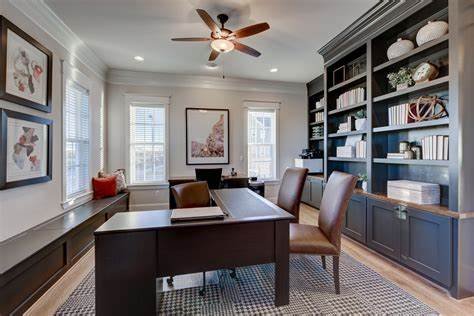In the age of remote work, creating an efficient and inspiring home office has become essential for many. Whether you’re repurposing a spare room or carving out a nook in a living space, the right design can significantly enhance productivity and well-being. This article will delve into creative and practical home office design ideas, offering insights on how to transform any space into a productive workspace.
Assessing Your Space and Needs
Identifying the Perfect Spot
The first step in designing a home office is identifying the right location. Ideally, choose a spot that is quiet and free from distractions. If you have a spare room, this can be an ideal choice. However, even a small nook or corner in a larger room can be effectively transformed into a functional workspace.
Evaluating Natural Light and Ventilation
Natural light is crucial for maintaining energy levels and reducing eye strain. Position your desk near a window if possible. Ensure the space is well-ventilated to keep the air fresh and invigorating. If natural light is limited, invest in good-quality artificial lighting.
Designing for Productivity and Comfort
Choosing the Right Furniture
Invest in ergonomic furniture to support your health and productivity. A comfortable chair with lumbar support and an adjustable desk are essential. Consider a sit-stand desk if you want the flexibility to change positions throughout the day.
Maximizing Space with Smart Storage Solutions
Storage is key to keeping your workspace organized and clutter-free. Utilize vertical space with shelves and wall-mounted organizers. Incorporate drawers and cabinets to store documents and supplies out of sight, maintaining a tidy environment.
Creating a Functional Layout
The layout of your home office should promote efficiency. Place frequently used items within arm’s reach. Ensure your computer screen is at eye level and your keyboard and mouse are positioned comfortably to prevent strain.
Personalizing Your Workspace
Incorporating Personal Touches
Personalizing your home office can make it more inviting and motivating. Add decor that inspires you, such as artwork, plants, or family photos. Choose a color scheme that boosts your mood and creativity.
Setting Up a Dedicated Work Area
Clearly define your work area to create a psychological boundary between work and home life. Use rugs, dividers, or furniture arrangement to delineate the space, especially if your office is part of a larger room.
Technology and Connectivity
Ensuring Reliable Internet and Connectivity
A fast and reliable internet connection is crucial for remote work. Position your workspace close to your router or invest in a Wi-Fi extender to ensure strong connectivity. Organize cables neatly using cable management solutions to avoid a tangled mess.
Integrating Essential Technology
Equip your home office with the necessary technology. This might include a high-quality computer, printer, and scanner. Consider dual monitors for increased productivity. Use docking stations to easily connect multiple devices.
Incorporating Smart Home Features
Smart home technology can enhance your workspace. Voice-activated assistants, smart lighting, and automated climate control can make your office more convenient and comfortable.
Fostering a Healthy Work Environment
Ergonomics and Posture
Good ergonomics are essential for preventing strain and injury. Adjust your chair and desk to maintain a neutral posture. Use a footrest if needed and take regular breaks to stretch and move around.
Lighting and Ambiance
Proper lighting is crucial for a productive workspace. Combine natural and artificial lighting to reduce eye strain. Use task lighting for focused activities and ambient lighting to create a pleasant atmosphere.
Incorporating Greenery
Plants can improve air quality and add a calming element to your office. Choose low-maintenance plants like succulents, or opt for air-purifying varieties like snake plants and peace lilies.
Balancing Work and Life
Creating Boundaries
Establish clear boundaries between work and home life. Set specific work hours and stick to them. Use your workspace exclusively for work-related activities to mentally separate work from relaxation.
Designing for Flexibility
Flexibility is key in a home office. Design a space that can adapt to different tasks and activities. A flexible layout and multi-functional furniture can help you make the most of your workspace.
Encouraging Breaks and Movement
Incorporate areas for breaks and relaxation. A cozy chair for reading or a yoga mat for stretching can provide a much-needed respite from desk work. Encourage regular breaks to rest your eyes and move your body.
Cost-Effective Solutions
DIY and Upcycling
You don’t need to spend a fortune to create a great home office. Consider DIY projects and upcycling to furnish your workspace. Repurpose furniture and use affordable materials to create custom solutions.
Budget-Friendly Decor
Decorate your office on a budget by shopping for second-hand items or using what you already have. Simple changes like a fresh coat of paint or new cushions can make a big difference.
Investing in Quality Essentials
While saving money is important, invest in quality essentials that will last. A good chair, sturdy desk, and reliable technology are worth the investment for long-term comfort and productivity.
Conclusion
Creating a functional and inviting home office is a rewarding endeavor that can significantly enhance your productivity and work-life balance. By carefully assessing your space, choosing the right furniture and technology, and personalizing your workspace, you can transform any area into a productive sanctuary. Remember, the best home office reflects your personal style and meets your specific needs, making it a place where you can thrive professionally and personally.


